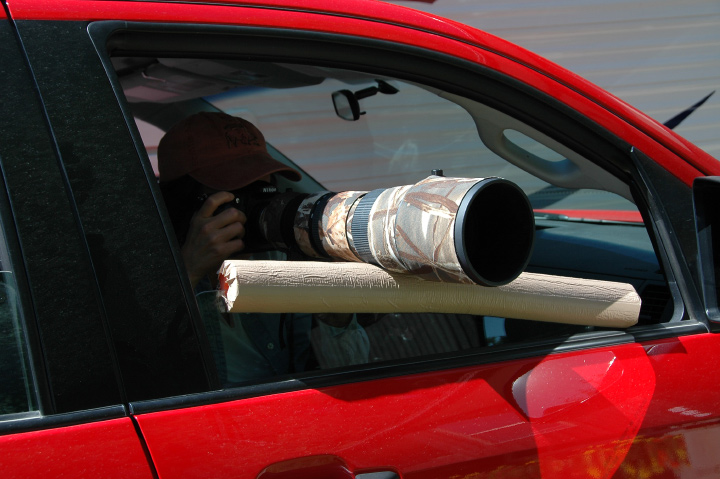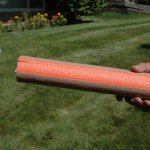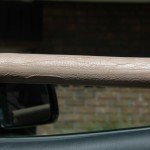Recently I was asked by Julie Brown if I had used a tripod when photographing some juvenile Cliff Swallows, I had not used a tripod but told her that I would write a post and explain what I was using for support when I took those photos. Here it is!
When I lived if Florida virtually 99.99% of my images were handheld using my Nikkor 80-400mm VR or Nikkor 70-300mm VR lenses attached to my Nikon D200. I found the weight of those lenses easy to carry all day long if needed and using them I was able to get closer to some birds without using a tripod.
I walked a lot there, sometimes up to 10 miles a day to get my images so weight was very important to me. Most of the time I was sitting in the waters of the Gulf of Mexico or in tidal lagoons. I was very comfortable handholding all of the time. I very rarely used my Nikkor 200-400mm VR with or without the 1.4x TC in Florida. I sure didn’t want to mess up an expensive lens by getting sand in it or dunking it into salt water.
Then…I moved back out west to Utah. Photographing here is very different than I was used to in Florida. The birds in Florida were used to human presence, that does not happen as often here. In local parks the birds here do seem to tolerate human presence well because they are exposed to them often.
But for the most part the birds here are a bit (or a lot) more skittish so I am often in a vehicle using it as a mobile blind. The birds seem far less nervous about a parked vehicle than they do a person standing outside of it using a tripod, there are always exceptions to that though. Some times the birds or animals are so engrossed in what they are doing that they will ignore a person standing quietly.
I admit to having a very difficult time getting used to not handholding all the time and shooting from the inside of a vehicle. I did not have the freedom or range of movement I was used to. I regrettably do miss shots now that I would not have missed on foot because I can not move my lens 360 degrees when I am inside a “mobile blind”.
I felt as though someone had staple-gunned me inside of a vehicle thus restricting my my ability to move unfettered.
When I first started flying out west again to photograph I was using a hand towel on the window to protect the window and the exterior of the lens. That was awful though, the towel would fall or blow out the window and it only provided a minimum of protection for the lens that rested on it. So I thought of using “pipe wrap”, those long closed-cell foam tubes with a slit down one side that is used to help prevent household plumbing pipes from freezing. Well, those sort of worked but the foam is probably less than a half inch thick and it broke down very rapidly. It also could easily fly up off of the window while driving, even at slow speeds. So while it was a good idea, it wasn’t that great.
I put my thinking cap back on and used my “noodle“.
I hadn’t moved to Utah yet when this idea struck me, but I was out here visiting & photographing with my friend Ron in June a few years ago. One afternoon I asked him to take me to the local Wal-mart and didn’t explain to him why I wanted to go there. Once we arrived I asked him to take me to the swimming pool supply section. I’m sure he must have thought the altitude in Utah compared to Florida had gone to my head. Or that I was just plain crazy(er).
I located my objective, those garishly colored, closed-cell foam “Noodles” with a narrow hole the entire length that kids use in swimming pools and picked one up and tucked it under my arm. Then I asked Ron to show me to the hardware section of the store. Once again I zeroed in on my next need, Duct Tape. I bet Ron really thought I had gone off the deep end then.
Back at his house I asked for a sharp knife. I still hadn’t told him what I was doing and I am surprised at that point he didn’t boot me out into the street, but nice guy that Ron is he brought down an electric carving knife to his garage.
I measured the width of his truck windows then cut a Noodle to those lengths. I used a strip of the Duct Tape to get a straight line down the length of the Noodle then proceeded to using the electric carving knife to cut half way through the Noodle, trying not to cut the opposite side of it where the center hole was. After completing that I placed more strips of Duct Tape to cover up the hideous orange color of the Noodle. I figured something that bright and hideous might scare away the birds or animals. After taping it and leaving an un-taped narrow area where the cut was I took it over and slid it down on the truck window.
Ron doesn’t think I am quite as crazy now. Maybe.
We took our Noodles out for a test. Our lenses were very well protected from getting scratched by the window, the closed cell-foam rises up over an inch or more from the edge. They do have Noodles in several thicknesses. We could rest our lenses on the Noodle and had the ability to slide them from one side of the window frame to the other. We didn’t have to worry about damaging the windows either. The windows can be adjusted to the height you desire by rolling it up and down.
The Noodles last a long time, but you shouldn’t squeeze the Noodle too tight often or it begins to split a line open on the inside. When new you can drive down a road with the Noodle slipped over the window edge at speeds in excess of 55 mph and the Noodle will stay put. As they age they do loosen a bit where the split is though so you might need to close the window up some to keep it in place.
A downside: You have to keep you hand on your gear, there isn’t a lens mount to keep the lens attached. I don’t find that to be an issue though as I just lay my gear over my lap when I am not using it.
The Duct Tape does at times squeak, you can resolve that issue by lightly buffing the Duct Tape with a medium grade sandpaper. When the Noodle wears out (splits) just make a new one. They pack easy too!
Total cost for three Noodles:
The Noodle: Around $1.88
The Duct Tape: $3.54 for a large roll.
That equals $5.42 divided by 3 is $1.80.
Yes, only $1.80 per Noodle.
A heck of a lot less expensive than spending $50 to $70 on a manufactured bean bag!
The Noodles help by stabilizing the lens better than just the edge of a window and the closed cell foam not only protects the glass and the exterior of the lens it also helps by absorbing the movement of the camera caused when the shutter button is depressed.
Using my “Noodle” hasn’t given me back the range of movement I had while photographing on foot handheld that I had in Florida but it sure has made photographing from the window of a mobile blind a much more pleasant experience.
So that is how I use my Noodle when photographing birds and animals.
Mia
* See the images below for a detailed look at the Noodle I described.










Now all you need to do is make it black and put “Nikon” on the outside. Then you can sell them for 50 times the cost! You have me convinced to get myself a “noodle” Thanks!
Josh, that is a really good idea about making the Noodle black with a yellow “Nikon” on it!
Thanks so much for the post Mia. I have been using a homemade bean bag for a while but am not really satisfied with it. Now I have something new to try. I am particularly intrigued by leaving it in place while driving. I sometimes do that with the bean bag but it is really, really awkward.
I think you will like the Noodle Larry.
Very creative. I notice when I go to Gandy beach, if I get out the car, the birds take off. I might have to try this.
A question I would love to get your opinion on. I have an old Sigma 150-500 that I bought used 2 years ago and is now pretty beat up. I was thinking of getting the Nikon 80-400 to replace it instead of another Sigma. I just recently bought a Nikon D7000. You seem to be okay with the 80-400. I had heard they focus pretty slow but if I’m used to the Sigma, then it would seem like the Nikon would be better. I would lose a little distance though. Any thoughts?
Thanks, Dina
Dina,
I had the same problem at Gandy Beach so I would sit in my Jeep instead of getting out. I used the 80-400mm VR almost all the time then so I didn’t need a Noodle as I used it handheld. Email soon to be on the way to answer your quesrion about the 80-400mm VR.
What a great idea – thanks for sharing! Thanks for posting the pics too, I just might have to get me one of those!
This is so helpful, Mia! Thanks for taking the time to write this up.
My pleasure Julie, I’ve been meaning to write a post on my Noodle idea for quite some time. Your question inspired me to do just that.